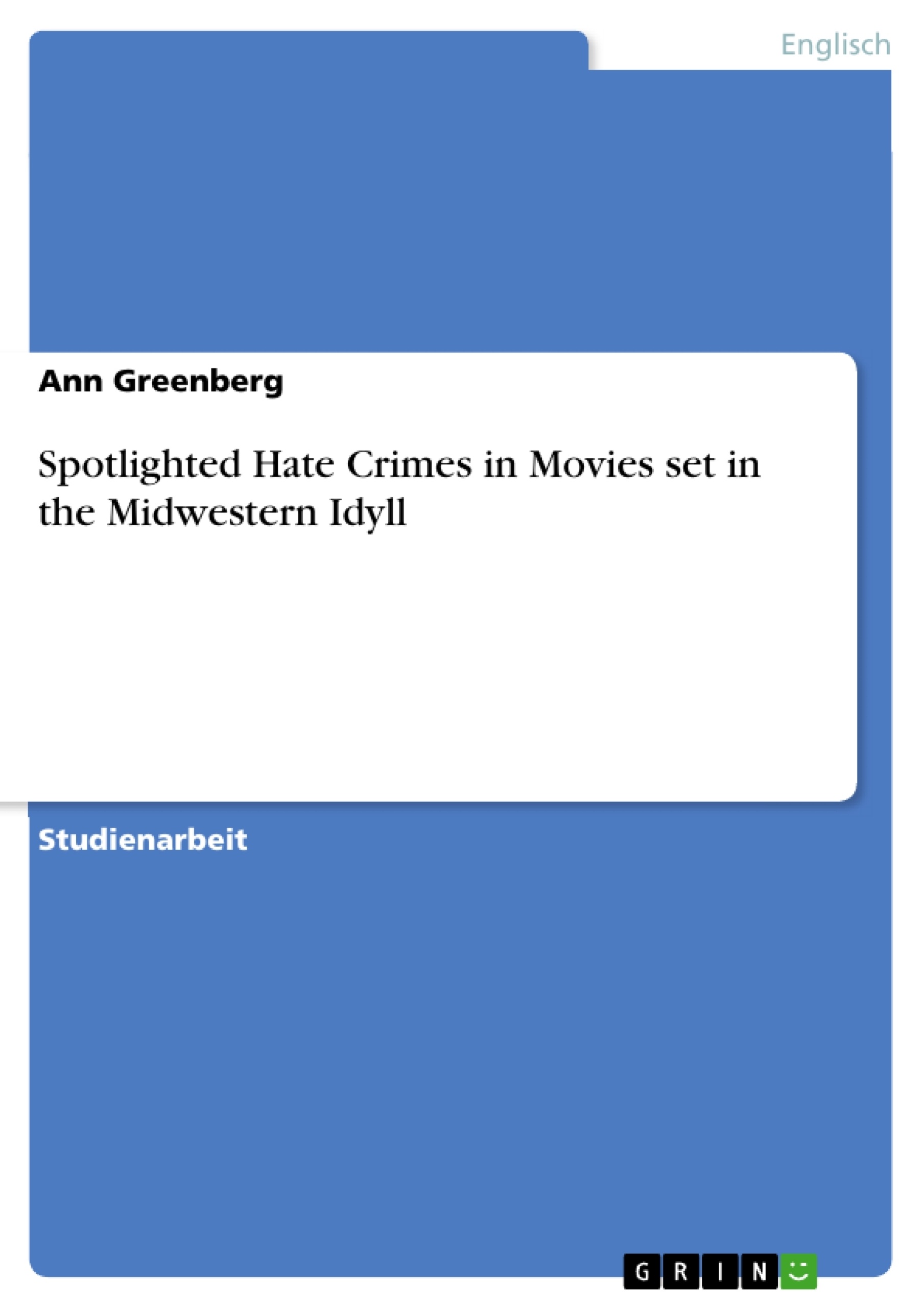The Great Plains and acres of farmland might be some of the first associations one has when thinking about the Midwest. Through various documentaries and movies a certain image of this area has been formed, a stereotypical ideal image so to say. The wide open range of the country is subject to many songs and more so to many movies.
The rural idyll is an expression that everybody can link at least a few thoughts and images to. Mostly, it is not only a stereotypical way of seeing the Midwestern towns and their residents, but it describes the idyll of an American town. Filmmakers and writers widely put this idyll to use with different goals. If either to underline the beauty of a love story or to use the idyll as a way to contrast with a plot telling a gruesome story.
Can the landscape of the Midwest, in the sense of a stereotypical idyll, be utilized to emphasize the brutality of hate crimes?
In order to answer this question, the construction of rural idyll will be explained, as will be the consequent concept of anti-idyll. Further the use of landscape in cinema will be described. In the analysis The Laramie Project (2002) and Boys Don't Cry (1999) will be used to show the utilization of landscape. The last part will explain how the use of idyll and anti-idyll can influence the perception of brutality.
Inhaltsverzeichnis
- Introduction
- The rural idyll
- Landscape in cinema
- Analysis of The Laramie Project (2002)
- Landscape
- Hate Crime
- Analysis of Boys Don't Cry (1999)
- Landscape
- Hate Crime
- Conclusion
- List of works cited
Zielsetzung und Themenschwerpunkte
Diese Arbeit untersucht, wie die Landschaft des Mittleren Westens, im Sinne eines stereotypen Idylls, dazu verwendet werden kann, die Brutalität von Hassverbrechen zu betonen. Die Arbeit analysiert die Konstruktion des ländlichen Idylls und den daraus resultierenden Begriff des Anti-Idylls. Sie untersucht auch die Verwendung von Landschaft im Kino und analysiert die Filme "The Laramie Project" (2002) und "Boys Don't Cry" (1999), um zu zeigen, wie die Landschaft genutzt wird. Schließlich wird die Arbeit untersuchen, wie die Verwendung von Idyll und Anti-Idyll die Wahrnehmung von Brutalität beeinflussen kann.
- Die Konstruktion des ländlichen Idylls und des Anti-Idylls
- Die Verwendung von Landschaft im Kino
- Die Analyse von "The Laramie Project" (2002) und "Boys Don't Cry" (1999)
- Der Einfluss von Idyll und Anti-Idyll auf die Wahrnehmung von Brutalität
Zusammenfassung der Kapitel
Das erste Kapitel führt in das Thema ein und stellt die Forschungsfrage: Kann die Landschaft des Mittleren Westens, im Sinne eines stereotypen Idylls, dazu verwendet werden, die Brutalität von Hassverbrechen zu betonen? Das zweite Kapitel erklärt die Konstruktion des ländlichen Idylls und den daraus resultierenden Begriff des Anti-Idylls. Es wird argumentiert, dass das ländliche Idyll ein Konstrukt ist, das durch Medien, Filme, Gedichte und Lieder geschaffen wurde. Das dritte Kapitel untersucht die Verwendung von Landschaft im Kino. Es wird argumentiert, dass Landschaft im Kino auf verschiedene Arten verwendet werden kann, z. B. als Raum, als Ort oder metaphorisch. Das vierte Kapitel analysiert den Film "The Laramie Project" (2002) und zeigt, wie die Landschaft verwendet wird, um die Brutalität eines Hassverbrechens zu betonen. Das fünfte Kapitel analysiert den Film "Boys Don't Cry" (1999) und zeigt, wie die Landschaft verwendet wird, um die Brutalität eines Hassverbrechens zu betonen. Das sechste Kapitel fasst die Ergebnisse der Arbeit zusammen und zieht Schlussfolgerungen.
Schlüsselwörter
Die Schlüsselwörter und Schwerpunktthemen des Textes umfassen das ländliche Idyll, das Anti-Idyll, die Landschaft im Kino, Hassverbrechen, "The Laramie Project" (2002), "Boys Don't Cry" (1999) und die Wahrnehmung von Brutalität. Der Text untersucht, wie die Landschaft des Mittleren Westens, im Sinne eines stereotypen Idylls, dazu verwendet werden kann, die Brutalität von Hassverbrechen zu betonen. Er analysiert die Konstruktion des ländlichen Idylls und den daraus resultierenden Begriff des Anti-Idylls. Er untersucht auch die Verwendung von Landschaft im Kino und analysiert die Filme "The Laramie Project" (2002) und "Boys Don't Cry" (1999), um zu zeigen, wie die Landschaft genutzt wird. Schließlich wird der Text untersuchen, wie die Verwendung von Idyll und Anti-Idyll die Wahrnehmung von Brutalität beeinflussen kann.
- Quote paper
- Ann Greenberg (Author), 2014, Spotlighted Hate Crimes in Movies set in the Midwestern Idyll, Munich, GRIN Verlag, https://www.grin.com/document/276058



